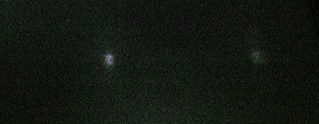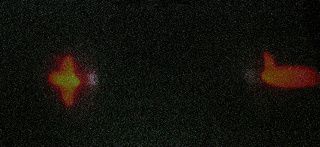Beacons Hardware
Beacon Overview
Each beacon contains two infrared (IR) LEDs and a lens that projects the IR output as two spots on the ceiling. Each beacon also has a touch-activated red LED that enables the user to position the IR spots optimally on the ceiling; the red LED shuts off after a (static?) time period. For optimal performance, both spots need to be visible to Rovio from every navigable position; the ceiling should be flat and preferably not heavily textured. The spots should be positioned near the center of the ceiling space with the largest separation between the spots attainable (empirical observations).
Visible markers
![]()
Infrared only

Infrared/visible merged

Room IDs and Frequencies
The Rovio navigation system allow use of up to 9 additional room beacons to extend the range that Rovio can navigate autonomously. Each beacon must be set to a unique ID from 1 through 9 by adjusting a collar selector.
Each ID is identified by driving the beacon IR LEDs at specific frequencies. Within one beacon, there is a difference of 960 Hz between the two LEDs; between each ID there is a difference of 120 Hz for each LED from the neighboring LED.
The Rovio recharging base is always ID=0, and the LEDs are driven at 3040 and 2010 Hz. Beacon ID 9 frequencies were measured at 5010 and 4050 Hz.
A complete table of frequencies:
| ID | Freq 1 | Freq 2 |
|---|---|---|
| 9 | 5010 | 4050 |
| 8 | 4890 | 3930 |
| 7 | 4770 | 3810 |
| 6 | 4650 | 3690 |
| 5 | 4530 | 3570 |
| 4 | 4410 | 3450 |
| 3 | 4290 | 3330 |
| 2 | 4170 | 3210 |
| 1 | 4050 | 3090 |
| 0 | 3040 | 2010 |
Detection and processing
Rovios IR detector (the flat round plate on top of the head) is able to determine the angular separation between the detector and each beacon spot. Internal processing converts this into a heading (Rovio fore/aft angle relative to the line connecting the two spots and distance (Rovio detector to the center point of the line connecting the two spots as viewed from above, eg. in the XY plane.)
